Earthquake. This kind of geological pehnomenon has been of most recent natural-disasters. When an earthquake hits, it can destroys any infrastructure human built, including building. That is why research and new method of construction develop to aim the earthquake-proof building. And also the method of planning, simulations, and many more.
One of the most important inventions is Building Shaker Quake Machine, a shaker machine created by "placing a building in" and "shake" it to simulate the earthquake.
How will a tall building react to earthquake-like stresses? Computer modeling has helped until now. Before it apllied to the real test on the field, the simulation performs by a computer modelling. Next image is the screenshot of the computer modelling.
 The simulations show how the specific parts of the building are moving. Comparing the real-world data with the computer model helps them improve their model; this improves the accuracy of the model when simulating the effects of stronger quakes.
The simulations show how the specific parts of the building are moving. Comparing the real-world data with the computer model helps them improve their model; this improves the accuracy of the model when simulating the effects of stronger quakes.
The powerful computer models that show a 275-tonne building being shaken to its foundations in unprecedented detail could help engineers better protect structures against earthquakes.
Engineers at the University of California in San Diego, US, have been using a giant "shake table" to reveal the affect of a 6.7 magnitude earthquake on a seven-storeys structure.
However, there is nothing like a good, real-world test. Engineers from the San Diego Supercomputer Center have combined the best of both worlds by putting up a full-size 275 ton building on a shake table.
 Not just any shake table - the world's largest outdoor Large High Performance (LHP) shake table developed for the Network for Earthquake Engineering Simulation (NEES) project.
Not just any shake table - the world's largest outdoor Large High Performance (LHP) shake table developed for the Network for Earthquake Engineering Simulation (NEES) project.
sources :
http://www.technovelgy.com
http://starspirit.stumbleupon.com
One of the most important inventions is Building Shaker Quake Machine, a shaker machine created by "placing a building in" and "shake" it to simulate the earthquake.
How will a tall building react to earthquake-like stresses? Computer modeling has helped until now. Before it apllied to the real test on the field, the simulation performs by a computer modelling. Next image is the screenshot of the computer modelling.
 The simulations show how the specific parts of the building are moving. Comparing the real-world data with the computer model helps them improve their model; this improves the accuracy of the model when simulating the effects of stronger quakes.
The simulations show how the specific parts of the building are moving. Comparing the real-world data with the computer model helps them improve their model; this improves the accuracy of the model when simulating the effects of stronger quakes.The powerful computer models that show a 275-tonne building being shaken to its foundations in unprecedented detail could help engineers better protect structures against earthquakes.
Engineers at the University of California in San Diego, US, have been using a giant "shake table" to reveal the affect of a 6.7 magnitude earthquake on a seven-storeys structure.
However, there is nothing like a good, real-world test. Engineers from the San Diego Supercomputer Center have combined the best of both worlds by putting up a full-size 275 ton building on a shake table.
 Not just any shake table - the world's largest outdoor Large High Performance (LHP) shake table developed for the Network for Earthquake Engineering Simulation (NEES) project.
Not just any shake table - the world's largest outdoor Large High Performance (LHP) shake table developed for the Network for Earthquake Engineering Simulation (NEES) project. The building was equipped with hundreds of sensors to yield precision data on how the building flexed during simulated quakes. It turned out that listening to audio and sensor data provided the key to comparing the film footage of the real building, and the pictures of the simulated building structure.
"By recreating the shake table experiment in movies in a virtual environment based on the observed data, this lets engineers explore all the way from viewing the 'big picture' of the entire building from a 360-degree viewpoint to zooming in close to see what happened to a specific support," said SDSC visualization scientist Amit Chourasia. "Integrating these disparate data elements into a visual model can lead to critical new insights."sources :
http://www.technovelgy.com
http://starspirit.stumbleupon.com




